A Private Tour today on the North Norfolk coast. It was a lovely sunny start to the day, and very mild out of the SE breeze, although there was a bit more cloud around at times in the afternoon. With several lingering rarities still along the coast, we decided on a day catching up with some of our scarcer winter visitors together with a bit of ‘twitching’!
Our first destination for the morning was Holkham. As we drove up along Lady Anne’s Drive, we could see some groups of Pink-footed Geese out on the grazing marshes. Several birds were right next to the road, so we stopped for a closer look. We could see their pink legs (and feet!), and small, dark bill with a pink band.
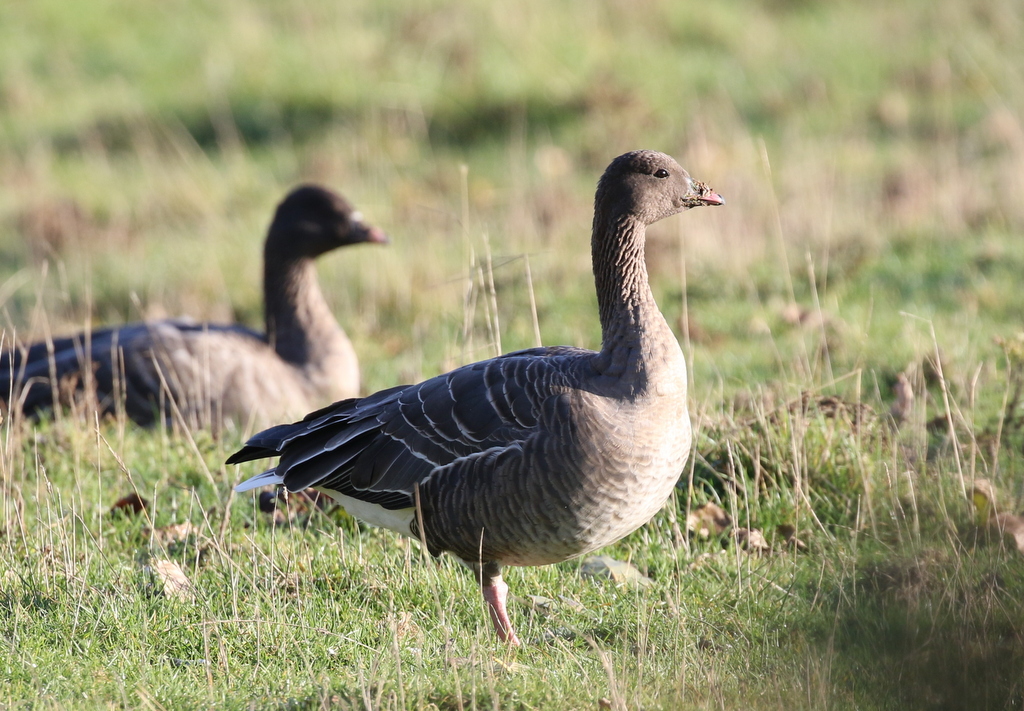
While we were watching the Pink-footed Geese, we looked up to see a large white bird flying away from us across the grazing marsh. It was a Great White Egret – we could see its long, dagger-shaped yellow bill. Great White Egrets have bred here for the last couple of years, but can be harder to find in winter, so this was a bonus.
Several small groups of Wigeon flew in to the pool on the other side of the road, but by the time we turned our attention to that side, they had gone back out to graze on the grass. We carried on up to the end of the Drive. A digger was clearing one of the ditches, piling the mud out on the bank, and two Grey Herons were standing by to take advantage of anything edible which it scooped out. As we got out of the car and scanned, a Marsh Harrier was quartering the marshes and a Kestrel was hovering nearby.
We walked through the pines and out onto the beach. Several Brent Geese were feeding out on the saltmarsh, so we stopped briefly to look at them through the scope. As we set off again, walking east, two Red Kites were hanging in the air over the dunes, flashing burnt rusty red as they circled in the morning sunshine. A Marsh Harrier flew past, a young bird, chocolate brown with a pale head, and then a rather pale Common Buzzard flew in over the saltmarsh and almost over our heads. The raptors were obviously out in force this morning enjoying the fine weather!

When we got out to the newly cordoned-off area of the saltmarsh, we could see a couple of small birds creeping about in the vegetation which caught the light. Looking more closely, we could see they were Shorelarks. We got them in the scope and could see their bright yellow faces, shining in the morning sunshine, contrasting with their black bandit masks and collars. Looking carefully, we counted six at first but then another five or so more flew in to join them.

Shorelarks are scarce and localised winter visitors to the UK most winters, and Holkham is a very traditional site for them. However, they are very vulnerable to disturbance and the beach here has become increasingly popular, particularly with dog walkers. Hopefully, the new fence, which was erected this week by the wardens, will help to keep disturbance to a minimum and will encourage them to remain here again for the winter.
While we were watching the Shorelarks, we could see a flock of Snow Buntings feeding further over, but by the time we had finished looking at the Shorelarks, they had disappeared. We walked over to the beach and scanned the shingle, as Snow Buntings can be very hard to spot when they get in the stones. But the next thing we knew they flew back in, flashing white in their wings and twittering, and landed behind us on the edge of the saltmarsh again.

We stopped to admire the Snow Buntings for a while, as they fed on the sparse seedy vegetation. They were very active, running around on the sand, occasionally flying up and landing again, always on the move.
After watching the Snow Buntings for a while, we turned our attention to the sea. Scanning the water, we spotted a few seaduck out in the Bay. They were not easy to see at first though – even though the sea looked fairly flat, it was surprising choppy, enough to hide the birds. First we came across two female Eider, with long wedge-shaped bills. Then we found three darker birds with two white spots on their faces, Velvet Scoter. They were busy diving for shellfish, but the white spots caught the sunlight when they surfaced.
A couple of Gannets flew past, white adults with black wingtips. Then we noticed a larger gathering of Gannets further out. One had obviously found a shoal of fish and attracted the others as they were all busy feeding. We watched as one after another folded back its wings and plunged headlong into the water.
There were a few other birds out on the sea too – a winter plumage Red-throated Diver, its white face catching the light, and several Great Crested Grebes too. A couple of Guillemots were not playing ball though, diving constantly so that they were impossible to see.
There were lots of gulls out on the beach too, plus several Oystercatchers, and a few Sanderling and Turnstone were flying back and forth out along the shoreline. A small group of Brent Geese were fast asleep right down by the water’s edge. Something had obviously spooked the Snow Buntings again, because they suddenly flew up over the dunes and landed out on the beach in front of us. We watched them busily preening in the sunshine before they eventually plucked up the courage to fly back again.

As we made our way back towards the Gap, the two Red Kites were still circling over the dunes – there must have been some carrion out there which they couldn’t resist. When we got back to Lady Anne’s Drive, three more were circling out over the grazing marshes on the other side of the pines.
Then, as we drove back towards the main road, we stopped to watch yet another Red Kite circling very close by. It dropped down into the grass and came back up with a rat in its talons. We couldn’t tell whether it had already been dead or not, but the Red Kite carried it out into the middle of the field and started to devour it.
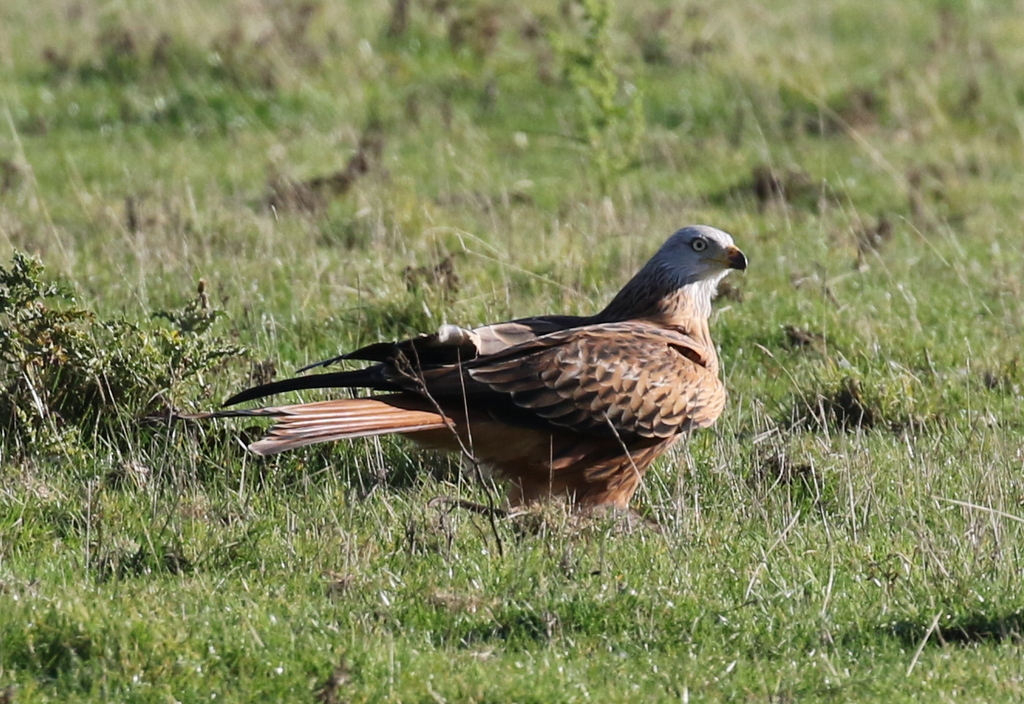
From Holkham, we headed east along the coast road to Kelling. There have been some Waxwings here for the last few days and we could see several large lenses pointed up into the dead tree right next to where we parked. They were right above our heads as we got out! Thankfully they didn’t seem to be in the least bit worried by us, and we walked across the road from where we could get a better angle to look at them.
With their punk haircuts and multi-coloured wing markings, Waxwings are one of the most charismatic birds and always worth a diversion to see. There were at least five of them here today. They occasionally dropped down to a neighbouring garden to feed on the rowan tree, then flew back up into the top of a dead tree, where they perched, digesting.
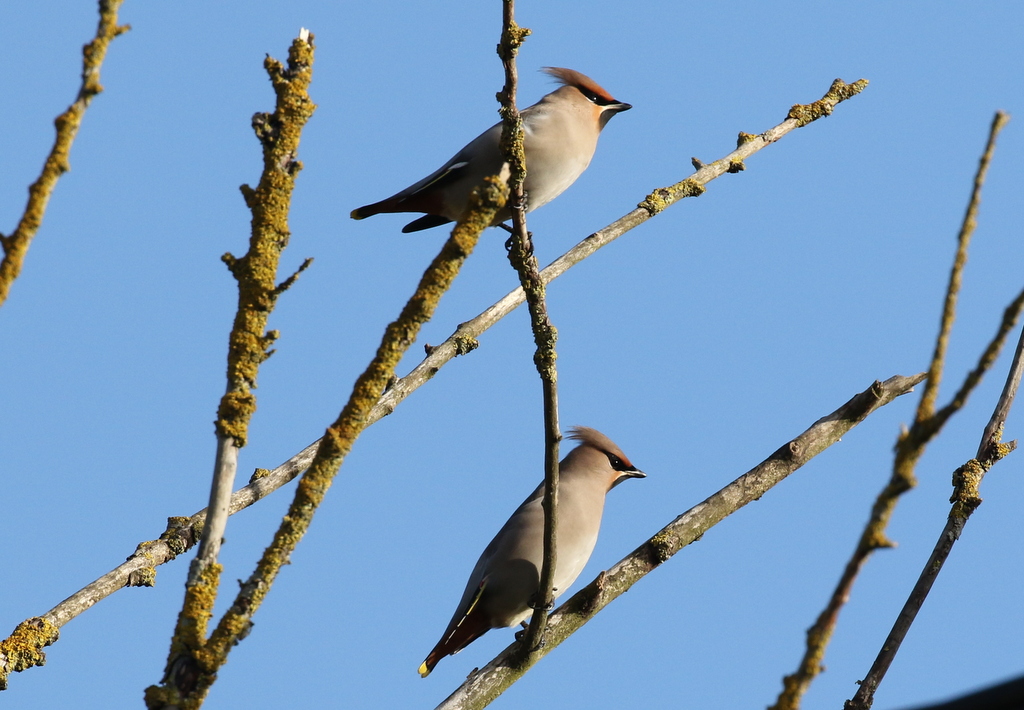
Up close, through the scope, we could make out all the details of the Waxwings wings – including the small red waxy tips to its secondaries, from which it gets its name, as well as the yellow tip to the tail and the rusty undertail.
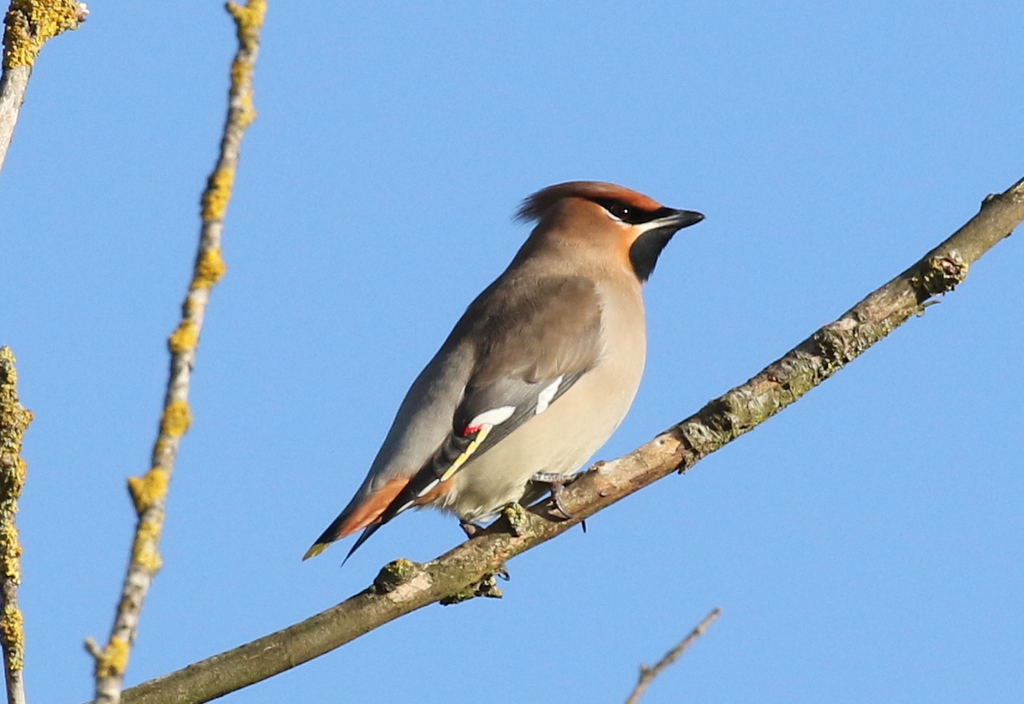
Eventually, we had to tear ourselves away from admiring the Waxwings. We were heading back to Cley for lunch, so we stopped at Salthouse on the way there. There had been no mention of the ‘Eastern’ Stonechat all morning, so after a clear night last night it seemed like it had most likely gone, continuing on its journey.
We had a quick look anyway, and there was no sign. Hopefully the Sparrowhawk which was in the bushes close to where it had been favouring, had not had a Stonechat shaped meal! There was a family of Mute Swans on duck pond and a flock of Canada Geese out on the grazing marshes. A Lapwing and a Curlew both flew past, and several Meadow Pipits came up ‘seep-seeping’ out of the grass.
We carried on to Cley for lunch. As we sat down at the picnic tables, a slightly ominous line of dark grey cloud blew in from the south. It hung over us for precisely as long as we sat out eating and then, as soon as we stood up, it cleared again and went back to sunshine!
While we were eating, we could see a couple of flocks of Black-tailed Godwits busy feeding on Pat’s Pool. There were obviously lots of ducks out on North Scrape, as we could see when they were flushed by a Marsh Harrier, and flew round, mainly Wigeon and Teal.
After lunch, we went for a quick walk up along the East Bank. We stopped to look at some Greylag Geese out on the grazing marsh, with their large orange carrot-bills, very different from the Pink-footed Geese we had looked at earlier. There were lots of ducks out on Pope’s Pool, mainly Wigeon and Teal again. There were some closer Shoveler and Gadwall on the Serpentine, as well as more Teal. As we stopped to admire them, a Common Snipe flew across the water but ran straight into the long grass on the other side.

It had clouded over again now, and with the wind seemingly having picked up a touch, we headed for the shelter to scan Arnold’s Marsh. There were plenty of Dunlin on here, scattered about in the shallow water, as well as a Grey Plover walking along the near edge, just beyond the vegetation. There were also several Redshank and Black-tailed Godwits, three Shelduck asleep at the back, and a few Cormorants drying their wings on the island.
Continuing on out towards the beach, a Little Egret was feeding in the reeds on the brackish pools. It seems to like it here!
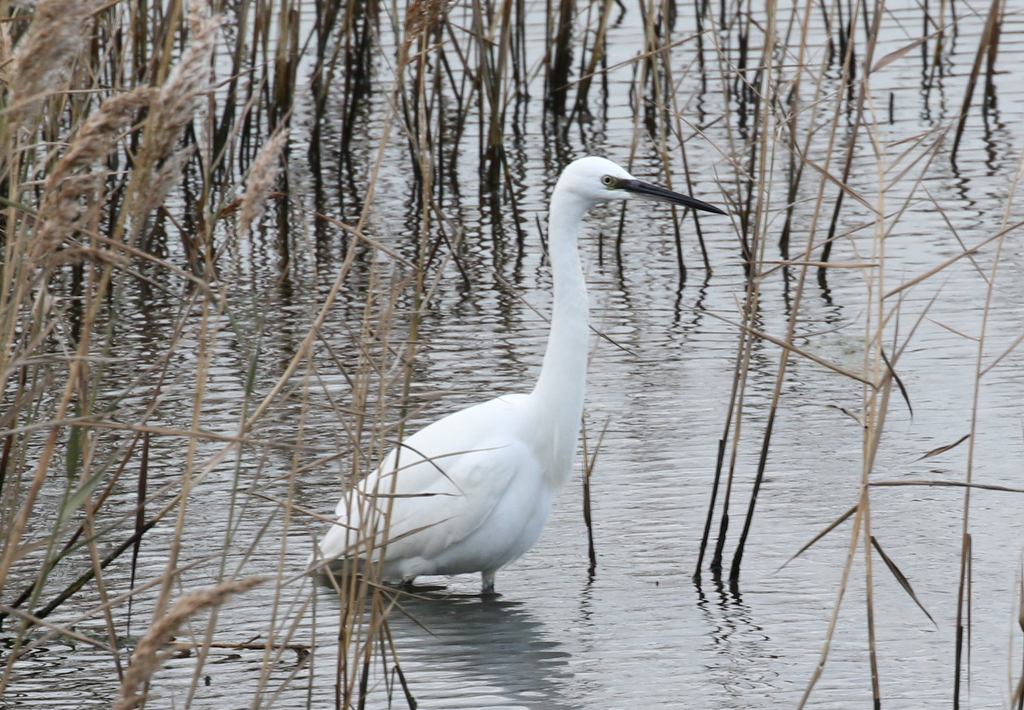
Looking out to sea, we spotted two Common Eider just offshore. They were drifting quickly west, but through the scope we could see their wedge-shaped bills. A female Common Scoter was also close in on the sea, dark-capped and pale-cheeked. More Gannets circled out over the sea and a large bull Grey Seal swam past.
We had one last target for the day, so we turned to head back. Suddenly, all the ducks erupted from North Scrape again. We scanned over the marshes, but we couldn’t see a Marsh Harrier out there this time. Then we noticed a Peregrine come up from behind the reeds. We watched as it circled round a couple of times, then it powered down towards the other scrapes and we lost sight of it behind the reeds as it shot across in front of Dauke’s Hide.
On the way back, we had a quick scan of the main drain, which produced a couple of Little Grebes. Then we drove further east along the coast road to Sheringham. There has been a young drake King Eider lingering off here for the last week or so. There were only one or two people looking for it now, late in the day, and they had lost sight of it. We scanned up through the flags, marking the position of the crab pots, and quickly relocated it again.
The King Eider is not at its smartest at the moment. It is just in its second winter and is still moulting out of its duller eclipse plumage, but it was still a treat to be able to watch this high arctic species so well south of its normal range. It was busy diving, presumably looking for the very crabs for which this area is so famous!
The light was fading fast now. Lots of Black-headed Gulls were gathered down on the beach below the cliffs, for a quick bath before heading off to bed. It had been a very enjoyable day out, but it was time for us to head off too now.
















